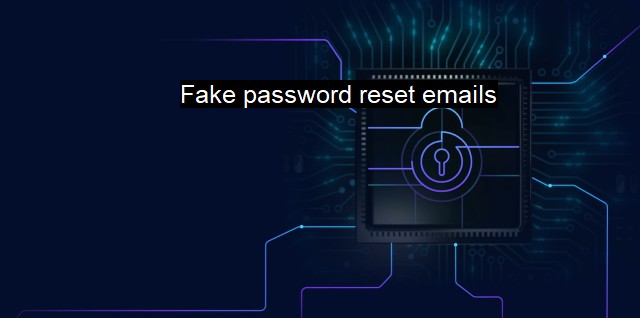What are Fake password reset emails?
How to Recognize and Protect Yourself from Fake Password Reset Emails in Today's Cyber Threat Environment
Fake password reset emails are a type of cyber attack typically used by cybercriminals for phishing and identity theft purposes. It is an illicit practice aimed at luring unsuspecting individuals into divulging sensitive information, like usernames and passwords, under the guise of resetting their account password.These emails often appear legitimate, mirroring the exact structure, logo, and formality of correspondence from trustworthy organizations. Sometimes, they even use spoofing techniques that make the email appear as if it originates from a reliable source. a hacker posing as a bank representative could use this approach to send unsolicited reset password emails to clients, intending to steal their account credentials.
The essence of these fake emails is to create a sense of urgency or worry among recipients, insisting that they need to reset their password to avoid a severe consequence such as account termination. By exploiting the recipient's fear, scammers trick them into clicking on provided links, often redirecting to malicious websites, where the victim inputs their personal information inadvertently.
What happens next is iconically terrible – the fraudulent party gains unauthorized access to the user's account. With this access, a malicious actor can do real harm, such as drain bank accounts, create unwanted subscriptions, make unauthorized transactions, change account details, or steal sensitive data. In the worst-case scenario, the collected data can also be used for illegal activities, ruining the victim's reputation.
From a cybersecurity perspective, these fake password reset emails are a fundamental concern. It challenges the static defenses put in place by organizations such as antivirus software and firewalls. Some particularly sophisticated phishing emails can elude these defenses, bypassing spam filters, and landing in the main inbox. Apart from the considerable financial distress it often causes, this type of fraud also risks permanent damage to an entity's brand.
Mitigating the risk these fake password reset emails pose requires both robust security infrastructure and end-user education. Measures include secure email systems that filter phishing emails, well-configured server parameters to fend off spoofing attempts, and regular updating of antivirus software to identify potential threats.
The barrier of user behavior remains the hardest to cope with. Most cyberattacks emanate from a point of human failure to recognize potential threats. Thus, educating users on potential indicators of phishing emails, such as grammatical errors, unsolicited requests, incorrect email addresses, generic greetings, or dodgy-looking URLs is crucial.
Fake password reset emails are no more than phishing tools used by cybercriminals to scam unsuspecting internet users. They are a critical concern in the modern digital landscape that requires concerted efforts from both cybersecurity professionals and end-users to adequately manage. Organizations need not only use the right defensive technology, such as antivirus software, but also educate their people continually on their role in maintaining security and how to spot potential security threats.

Fake password reset emails FAQs
What are fake password reset emails?
Fake password reset emails are fraudulent emails that appear to be from legitimate companies or organizations to trick users into providing their login credentials. These emails contain a link or attachment that leads to a fake website or malware installation.How to identify a fake password reset email?
You can identify a fake password reset email in several ways. The email may contain spelling or grammar errors, have a suspicious sender address, or include urgent language. Also, check the destination URL before clicking on any links or downloading attachments.What should I do if I receive a fake password reset email?
If you receive a fake password reset email, do not click on any links or download any attachments. Delete the email immediately or report it to your IT department or the email provider.How can I protect myself from fake password reset emails?
To protect yourself from fake password reset emails, use a strong and unique password for each account, enable two-factor authentication, and keep your antivirus software up to date. Also, be cautious when opening emails from unfamiliar or suspicious senders and avoid clicking on links or downloading attachments from those emails.| | A | | | B | | | C | | | D | | | E | | | F | | | G | | | H | | | I | | | J | | | K | | | L | | | M | |
| | N | | | O | | | P | | | Q | | | R | | | S | | | T | | | U | | | V | | | W | | | X | | | Y | | | Z | |
| | 1 | | | 2 | | | 3 | | | 4 | | | 7 | | | 8 | | |||||||